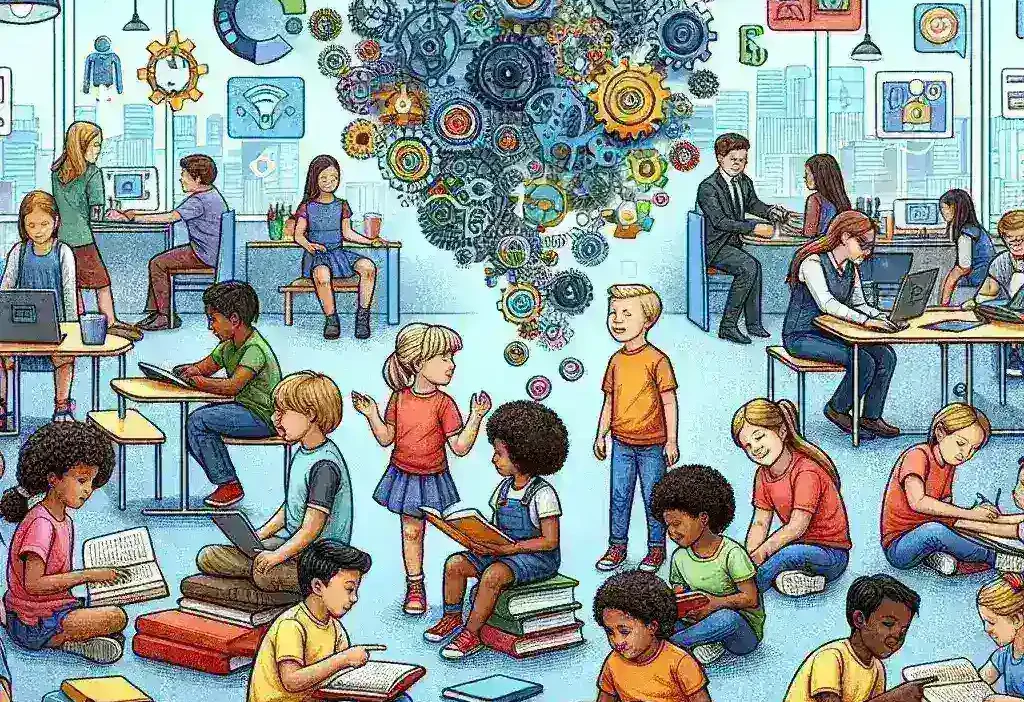The Evolution of Educational Technology: How AI is Transforming Learning
The landscape of education has undergone remarkable transformation over the past decade. From traditional chalk-and-talk methods to interactive digital platforms, the journey has been nothing short of revolutionary. At the forefront of this educational metamorphosis stands artificial intelligence—a technology that’s not merely changing how we teach but fundamentally reshaping how we understand learning itself.
Educational institutions worldwide are increasingly embracing AI solutions to enhance teaching methodologies and improve student outcomes. The global AI in education market, valued at $1.82 billion in 2021, is projected to reach $20.54 billion by 2028, reflecting a compound annual growth rate of 41.2%. This explosive growth underscores the significant role AI is playing in reshaping educational paradigms.
One of the most promising applications of AI in education lies in its ability to identify and address learning gaps—those critical knowledge deficits that can hinder a student’s educational progress if left undetected. Traditional educational systems often struggle to pinpoint these gaps efficiently, especially in classroom settings with diverse learning needs.
Understanding Learning Gaps: The Educational Challenge
Before delving into AI solutions, it’s essential to understand what learning gaps are and why they pose such significant challenges in educational settings.
What Are Learning Gaps?
Learning gaps represent disparities between what students are expected to know and what they actually understand. These gaps can manifest in various forms:
- Conceptual gaps: Misunderstandings or incomplete knowledge of fundamental concepts
- Skill gaps: Inability to perform specific academic skills at the expected level
- Knowledge gaps: Missing information or facts that serve as building blocks for more advanced learning
- Application gaps: Difficulty applying learned concepts to new situations or problems
Learning gaps often accumulate over time, creating cascading effects that can significantly impair educational progress. A student who doesn’t grasp basic multiplication, for instance, will struggle with division, fractions, and eventually algebra—creating a widening chasm of understanding that becomes increasingly difficult to bridge.
Traditional Approaches to Identifying Learning Gaps
Historically, educators have relied on several methods to identify learning gaps:
- Standardized testing
- Classroom assessments
- Homework evaluation
- One-on-one student conferences
- Observational assessment
While valuable, these approaches often suffer from significant limitations. They’re typically time-intensive, intermittent rather than continuous, and may not capture the nuanced nature of individual learning patterns. Moreover, they frequently identify gaps only after they’ve become substantial—when remediation becomes more challenging.
The traditional educational model also faces inherent structural limitations in addressing these gaps once identified. With one teacher responsible for guiding many students, providing the individualized attention needed to address specific learning gaps becomes practically impossible.
AI as a Game-Changer in Identifying Learning Gaps
Artificial intelligence brings transformative capabilities to the educational landscape, offering unprecedented opportunities to identify learning gaps with precision and efficiency.
Continuous Assessment through AI-Powered Learning Platforms
Unlike traditional assessments that provide periodic snapshots of student understanding, AI-powered platforms enable continuous, real-time monitoring of student performance. These systems analyze patterns in how students interact with educational content, identifying struggling points that might indicate learning gaps.
For example, adaptive learning platforms like DreamBox Learning and Carnegie Learning continuously evaluate student responses to mathematical problems. The AI doesn’t just mark answers as correct or incorrect—it analyzes the specific approach used by students, identifying misconceptions or procedural errors that point to underlying learning gaps.
Natural Language Processing for Comprehension Analysis
Advanced natural language processing (NLP) capabilities enable AI systems to analyze student writing and verbal responses with remarkable depth. These systems can identify conceptual misunderstandings that might not be apparent through multiple-choice assessments.
When a student writes an essay or provides an explanation, NLP algorithms can detect inconsistencies or misconceptions in their understanding. For instance, if a student consistently misuses scientific terminology or demonstrates flawed logical reasoning, the AI can flag these patterns as potential learning gaps requiring attention.
Behavioral Analysis and Engagement Metrics
Learning gaps often manifest behaviorally before they become apparent academically. AI systems track engagement metrics—time spent on different types of problems, hesitation patterns, frequency of help requests—to identify potential struggles before they translate into poor performance.
If a student consistently spends more time on certain types of problems or frequently accesses hints for specific concepts, the AI can recognize these patterns as early warning signs of learning gaps, enabling proactive intervention.
Predictive Analytics to Forecast Future Gaps
Perhaps most impressively, AI systems employ sophisticated predictive analytics to forecast potential learning gaps before they fully develop. By analyzing historical performance data across thousands of students, these systems can identify which current performance patterns correlate with future learning challenges.
This predictive capability allows educators to implement preventative measures rather than remedial ones—addressing learning gaps at their inception rather than after they’ve become entrenched.
Addressing Learning Gaps: AI-Powered Solutions
Identifying learning gaps is only half the battle; addressing them effectively represents the other critical component. Here again, AI offers revolutionary approaches that transcend traditional remediation methods.
Personalized Learning Pathways
One of AI’s most significant contributions to education is the creation of truly personalized learning experiences tailored to individual student needs.
Once AI systems identify specific learning gaps, they can automatically generate customized learning pathways designed to address those precise deficiencies. Unlike the one-size-fits-all approach of traditional education, these personalized pathways consider:
- The specific nature of the learning gap
- The student’s learning preferences and strengths
- The optimal sequence for introducing remedial content
- The most effective presentation methods for that particular student
Platforms like Knewton and ALEKS use sophisticated algorithms to create these personalized learning journeys. As students progress, the AI continuously refines the pathway based on performance, ensuring that the learning experience remains optimally targeted to addressing identified gaps.
Adaptive Content Delivery
Beyond creating personalized pathways, AI systems adapt the actual content delivery to match student needs. This adaptation can take several forms:
- Difficulty adjustment: Automatically modifying the complexity of problems based on student performance
- Format variation: Presenting content in different formats (visual, textual, interactive) based on learning preferences
- Pace modulation: Adjusting the speed at which new content is introduced
- Review frequency: Strategically reintroducing previously learned concepts for reinforcement
For instance, if a student demonstrates a learning gap in fraction operations, an AI system might initially present simplified visual representations, gradually transitioning to numerical notations as understanding improves. The system might also increase the frequency of fraction problems in subsequent lessons to reinforce the concept.
Intelligent Tutoring Systems
AI-powered intelligent tutoring systems (ITS) represent one of the most sophisticated approaches to addressing learning gaps. These systems go beyond content delivery to provide interactive, personalized tutoring experiences.
Modern ITS platforms like Squirrel AI and Carnegie Learning’s MATHia employ complex algorithms that mimic the strategies of effective human tutors. They can:
- Ask probing questions to identify the root of misunderstandings
- Provide step-by-step guidance through problem-solving processes
- Offer contextual hints rather than direct answers
- Recognize and address common misconceptions
- Adjust explanations based on student responses
Research has demonstrated that these intelligent tutoring systems can be remarkably effective in addressing learning gaps. A meta-analysis published in the Journal of Educational Psychology found that students using intelligent tutoring systems performed better than 75% of students receiving traditional instruction.
Gamification and Engagement Strategies
AI systems increasingly incorporate gamification elements to maintain student engagement during remediation activities. By analyzing individual student preferences and responses, these systems can determine which game mechanics will most effectively motivate specific students.
For a student with a learning gap in vocabulary development, an AI system might generate personalized word games that specifically target the missing vocabulary while incorporating game elements that appeal to that particular student’s interests and motivational triggers.
Real-World Implementation: AI Success Stories in Addressing Learning Gaps
The theoretical benefits of AI in identifying and addressing learning gaps are compelling, but the real-world implementations provide even more convincing evidence of its transformative potential.
Case Study: Carnegie Learning’s MATHia
Carnegie Learning’s MATHia platform exemplifies the power of AI in addressing mathematical learning gaps. The system provides personalized math learning experiences by continuously analyzing student work to identify misconceptions and knowledge gaps.
In a study involving 6,000 students across multiple school districts, those using MATHia demonstrated 2-3 times the growth in mathematical achievement compared to those using traditional instructional methods. The system was particularly effective for students who entered with significant learning gaps, helping them achieve growth rates that enabled them to catch up with peers.
Case Study: Squirrel AI in China
Squirrel AI Learning has pioneered AI-driven adaptive learning in China, with remarkable results in addressing learning gaps. The system breaks down subjects into thousands of knowledge points and continuously assesses student mastery of each point, creating ultra-personalized learning pathways.
In comparative studies, students using Squirrel AI improved their test scores by an average of 26.7% more than those in traditional classrooms over the same period. The system was particularly effective at identifying and remediating subtle learning gaps that might have gone undetected in traditional educational settings.
Case Study: Third Space Learning
Third Space Learning combines human tutoring with AI analysis to address learning gaps in mathematics. The AI system analyzes recordings of tutoring sessions, identifying patterns in student misunderstandings and guiding tutors on effective intervention strategies.
Schools implementing Third Space Learning reported that 70% of students who began below grade level achieved or exceeded grade-level standards after six months with the program. The AI component was crucial in rapidly identifying specific learning gaps and ensuring that tutoring sessions precisely targeted these deficiencies.
Challenges and Considerations in AI Implementation
Despite its tremendous potential, implementing AI solutions for identifying and addressing learning gaps isn’t without challenges and considerations.
Equity and Access Concerns
Perhaps the most significant concern surrounding AI educational technologies involves equity and access. These powerful tools risk exacerbating educational disparities if they’re only available to affluent schools or students with reliable technology access.
Addressing this challenge requires concerted efforts from policymakers, educational institutions, and technology providers to ensure equitable access to AI-powered educational tools. This might involve:
- Subsidized technology programs for underresourced schools
- Development of low-bandwidth versions of AI educational platforms
- Public-private partnerships to expand technology infrastructure
- Open-source AI educational tools that can be widely implemented
Data Privacy and Security
AI educational systems collect vast amounts of data about student learning patterns and behaviors. This data collection raises legitimate concerns about privacy and security, particularly for younger students.
Responsible implementation requires robust data protection measures, transparent policies about data usage, and appropriate consent mechanisms for students and parents. Educational institutions must also ensure compliance with regulations like FERPA (Family Educational Rights and Privacy Act) and COPPA (Children’s Online Privacy Protection Act).
Teacher Integration and Professional Development
AI tools for identifying and addressing learning gaps achieve their maximum effectiveness when properly integrated with teacher expertise. This integration requires comprehensive professional development to help educators understand how to:
- Interpret AI-generated insights about student learning gaps
- Effectively combine AI recommendations with their professional judgment
- Use AI tools to complement rather than replace human instruction
- Address student questions and concerns about AI-powered learning
Schools implementing AI solutions should allocate sufficient resources for ongoing teacher training and support, recognizing that effective implementation is a process rather than a one-time event.
Algorithmic Bias and Fairness
AI systems can inadvertently perpetuate or amplify biases present in their training data or design. In educational contexts, this could lead to systematic disadvantages for certain student groups.
Addressing algorithmic bias requires diverse development teams, careful assessment of training data, regular auditing of system outputs for disparate impacts, and continuous refinement of algorithms to ensure fairness across different student populations.
The Future of AI in Addressing Learning Gaps
As AI technology continues to evolve, its capabilities for identifying and addressing learning gaps will expand in exciting new directions.
Multimodal Learning Gap Assessment
Future AI systems will increasingly incorporate multimodal assessment capabilities—analyzing not just written responses but also verbal explanations, visual problem-solving approaches, and even physical demonstrations of understanding.
These systems might use computer vision to assess how a student manipulates physical math manipulatives, voice analysis to evaluate reading fluency, or gesture recognition to analyze how students approach spatial reasoning tasks. This multimodal approach will enable more comprehensive identification of learning gaps across diverse skill domains.
Emotion-Aware AI
Emerging affective computing technologies will enable AI educational systems to recognize and respond to students’ emotional states during learning. This capability is particularly relevant for addressing learning gaps, as emotional factors like frustration, anxiety, or disengagement often accompany and exacerbate these gaps.
By detecting signs of negative emotional states during learning activities, AI systems could adjust their approach—perhaps offering encouragement, simplifying the immediate task, or suggesting a brief break—to help students maintain productive engagement with challenging material.
Collaborative AI-Human Teaching Models
The future will likely see increasingly sophisticated collaborative models that optimally combine AI capabilities with human teaching expertise. Rather than viewing AI as a replacement for teachers, these models will leverage the complementary strengths of both:
- AI systems excelling at continuous assessment, pattern recognition, and personalization
- Human teachers providing emotional support, contextual understanding, and creative problem-solving approaches
In these collaborative models, AI might identify specific learning gaps and suggest potential remediation approaches, while teachers make final decisions about implementation and provide the human connection essential for effective learning.
Lifelong Learning Gap Management
As AI educational systems become more integrated across educational levels and contexts, they will increasingly support lifelong learning gap management. Individual learning profiles could potentially follow students throughout their educational journeys, ensuring continuous, cumulative addressing of learning gaps.
A student’s specific challenges with algebraic concepts in middle school, for instance, could inform how related concepts are presented in high school and college, ensuring that early learning gaps don’t create cascading effects throughout their education.
Conclusion: A New Era in Educational Gap Closure
The integration of artificial intelligence into educational systems represents a paradigm shift in how we identify and address learning gaps. For the first time in educational history, we have tools capable of providing truly personalized, continuously adaptive learning experiences at scale.
By precisely identifying learning gaps through continuous assessment, pattern analysis, and predictive modeling, AI systems enable targeted interventions that address the specific needs of each student. Through personalized learning pathways, adaptive content delivery, and intelligent tutoring, these systems can help students overcome learning gaps more effectively than ever before.
However, realizing this potential requires thoughtful implementation that addresses concerns about equity, privacy, teacher integration, and algorithmic fairness. It also demands a balanced perspective that values AI as a powerful tool to augment human teaching rather than replace it.
As we navigate this new educational frontier, the north star must remain student success. When properly implemented, AI applications for identifying and addressing learning gaps can help fulfill education’s fundamental promise: enabling every student to achieve their full potential, regardless of their starting point or learning challenges.
The journey toward this vision has only begun, but the early results offer compelling evidence that AI-powered approaches to learning gaps could help create more equitable, effective educational experiences for all students. As these technologies continue to evolve and mature, their impact on educational outcomes will likely grow increasingly profound, potentially transforming how we conceptualize and address the age-old challenge of learning gaps in education.




